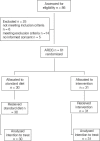Efficacy and safety of parenteral omega 3 fatty acids in ventilated patients with acute lung injury
- PMID: 21814375
- PMCID: PMC3145294
- DOI: 10.4103/0972-5229.83019
Efficacy and safety of parenteral omega 3 fatty acids in ventilated patients with acute lung injury
Abstract
Objective: To determine the effects of parenteral omega 3 fatty acids (10% fatty acids) on respiratory parameters and outcome in ventilated patients with acute lung injury.
Measurements and main results: Patients were randomized into two groups - one receiving standard isonitrogenous isocaloric enteral diet and the second receiving standard diet supplemented with parenteral omega 3 fatty acids (Omegaven, Fresenius Kabi) for 14 days. Patients demographics, APACHE IV, Nutritional assessment and admission category was noted at the time of admission. No significant difference was found in nutritional variables (BMI, Albumin). Compared with baseline PaO(2)/FiO(2) ratio (control vs. drug group: 199 ± 124 vs. 145 ± 100; P = 0.06), by days 4, 7, and 14, patients receiving the drug did not show a significant improvement in oxygenation (PaO(2)/FiO(2): 151.83 ± 80.19 vs. 177.19 ± 94.05; P = 0.26, 145.20 ± 109.5 vs. 159.48 ± 109.89; P = 0.61 and 95.97 ± 141.72 vs. 128.97 ± 140.35; P = 0.36). However, the change in oxygenation from baseline to day 14 was significantly better in the intervention as compared to control group (145/129 vs. 199/95; P < 0.0004). There was no significant difference in the length of ventilation (LOV) and length of ICU stay (LOS). There was no difference in survival at 28 days. Also, there was no significant difference in the length of ventilation and ICU stay in the survivors group as compared to the non survivors group.
Conclusions: In ventilated patients with acute respiratory distress syndrome, intravenous Omega 3 fatty acids alone do not improve ventilation, length of ICU stay, or survival.
Keywords: Acute lung injury; enteral diet; length of stay; mechanical ventilation; oxygenation; parenteral Omega 3 fatty acids.
Conflict of interest statement
Figures
References
-
- Ventilation with lower tidal volumes as compared with traditional tidal volumes for acute lung injury and the acute respiratory distress syndrome. N Engl J Med. 2000;342:1301–8. - PubMed
-
- Brower RG, Lanken PN, MacIntyre N, Matthay MA, Morris A, Ancukiewicz M, et al. Higher versus lower positive end-expiratory pressures in patients with the acute respiratory distress syndrome. N Engl J Med. 2004;351:327–36. - PubMed
-
- Halliwell B, Chiricos S. Lipid peroxidation: Its mechanism, measurement and significance. Am J Clin Nutr. 1993;57(5 Suppl):715S–24S. - PubMed
-
- Calder PC. Long-chain n-3 fatty acids and inflammation: Potential application in surgical and trauma patients. Braz J Med Biol Res. 2003;36:433–46. - PubMed
-
- Gadek JE, DeMichele SJ, Karlstad MD, Pacht ER, Donahoe M, Albertson TE, et al. Effect of enteral feeding with eicosapentaenoic acid, gamma-linolenic acid, and antioxidants in patients with acute respiratory distress syndrome: Enteral Nutrition in ARDS Study Group. Crit Care Med. 1999;27:1409–20. - PubMed
LinkOut - more resources
Full Text Sources


